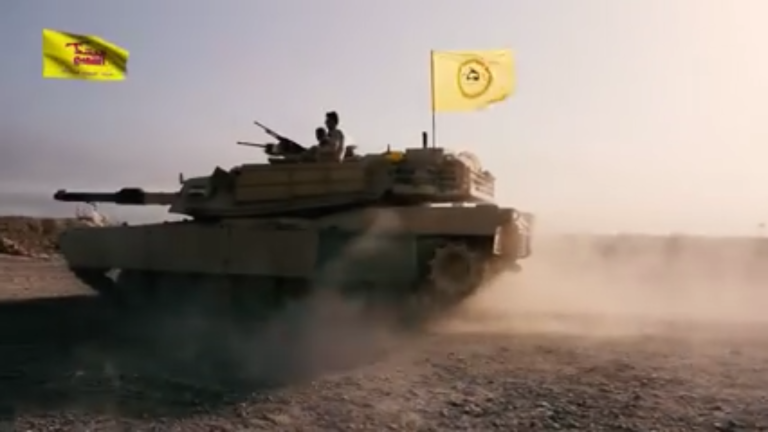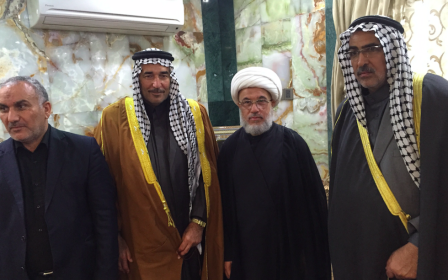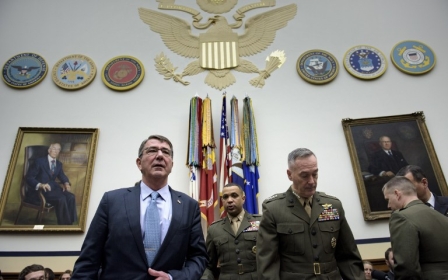American tanks and weapons used by pro-Assad Iraqi militias

An Iranian-backed Iraqi militia that actively supports the Syrian government is fighting with American tanks and equipment, according to reports and a video released by the group.
A video posted this week on Youtube shows the flag of the Kata’ib Sayyid al-Shuhada (KSS) flying from the back of an M1 Abrams, the US military's main battle tank.
The KSS forms part of the umbrella group Hashd al-Shaabi, or Popular Mobilisation Units. The PMU was formed in 2014 on the orders of Ali al-Sistani, the spiritual leader of Iraqi Shias, and which has since been funded by the Baghdad government.
The KSS has fought the Islamic State (IS) group in Iraq but has also sent forces to support Syrian President Bashar al-Assad and defend the Zaynab Shrine south of Damascus, which has been the target of repeated attacks by IS.
The date and location of the video is not verified. However, the Long War Journal reported that the footage was likely taken recently in Iraq's Salahedin province, where the KSS has fought several battles with IS.
The Abrams tank is also likely to be the property of the Iraqi army, which was rearmed by the US after the fall of Saddam Hussein in 2003 and which now fights alongside the PMU.
But the use of American weaponry by the KSS further muddies the complex web of alliances in the war in Syria and Iraq, and raises the possibility that Iran has indirect access to American military technology.
The KSS has not been designated a terrorist organisation by the US. However, it is closely linked to the Lebanese Hezbollah movement, which is on the US State Department's list of foreign terrorist groups.
It is also not the first Iraqi Shia militias have been photographed using American weaponry: The Badr organisation recently posted an image of fighters flying its flag from an Abrams tank and Hezbollah Brigades, which is on the US list of terrorist groups, has also posted video of its fighters using US equipment in Iraq's Anbar province.
Renad Mansour, who has written extensively on the PMU for the Carnegie Middle East Centre, said that the KSS's use of American weapons was unsurprising, and one of a big list of "embarrassments" with US policy in Iraq.
"It's a difficult line to pursue: basically, the Islamic State is enemy number one. Assad seems to be enemy number two. Insofar as that is the case, the US is forced to deal with these paramilitaries, which are the strongest force in the south and centre [of Iraq]," he told Middle East Eye.
"The PMU has become an official leg of the Iraqi state. [Prime Minister Haider] Abadi has decided to pay the PMU, and of course part of this is providing such support."
He said there was some risk that the weaponry could end up in Syria defending the Assad government, "however the priority for many of the PMU groups is the Iraq theatre. Had this been pre-2014, it would more likely be the case."
The US, he said, has had to accept the reaility on the ground in Iraq: that regular forces under the command of the Ministry of Defence were now seen as less legitimate than those operating under the PMU.
"Without their own troops on the ground, they need capable allies," he said of the US, adding that previous attempts by Washington to bolster regular forces had failed.
The US spent billions of dollars equipping and training the post-Saddam Iraqi army, which has been dogged by corruption, poor recruitment levels and low morale.
The IS group seized huge stockpiles of US-made weaponry from the Iraqi army during the fall of Mosul in 2014, including a reported 2,300 Humvee vehicles, plus artillery and man-portable missiles.
In a report in December, Amnesty International stated that the Middle East has been flooded with weaponry from the US, among others, which was falling into the hands of proscribed groups.
MEE contacted the US State Department on the issues surrounding the indirect arming of Shia militias, but it did not respond before publication.
New MEE newsletter: Jerusalem Dispatch
Sign up to get the latest insights and analysis on Israel-Palestine, alongside Turkey Unpacked and other MEE newsletters
Middle East Eye delivers independent and unrivalled coverage and analysis of the Middle East, North Africa and beyond. To learn more about republishing this content and the associated fees, please fill out this form. More about MEE can be found here.




